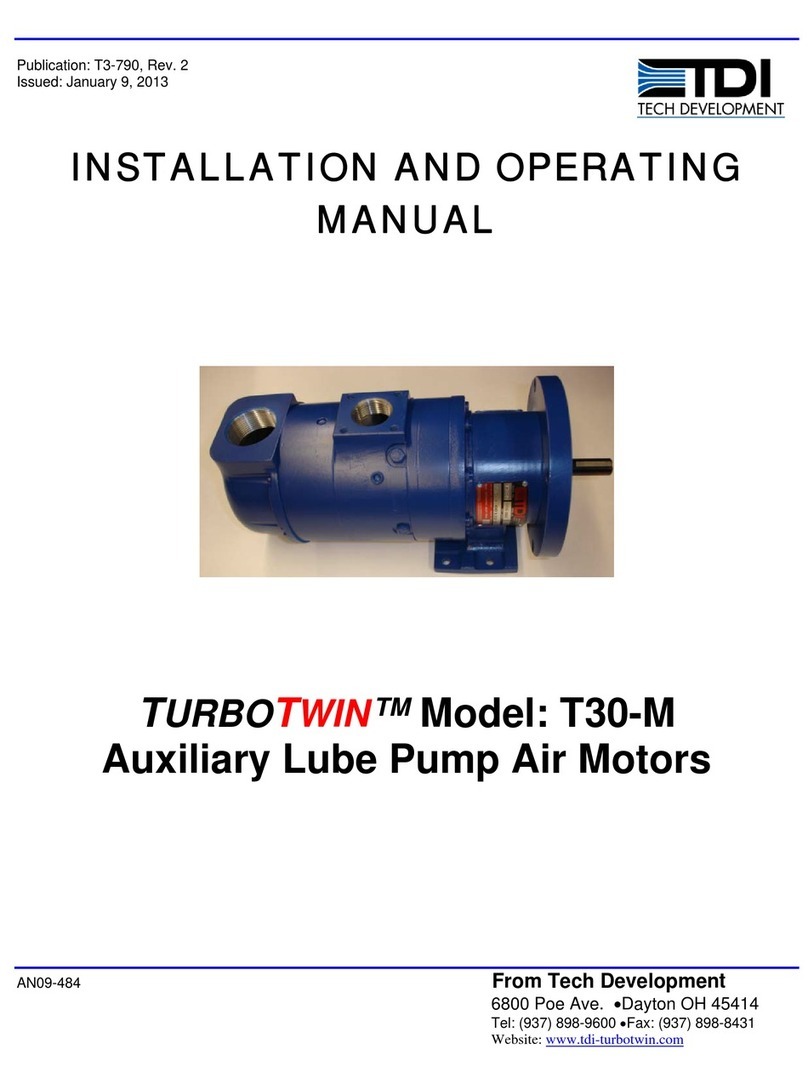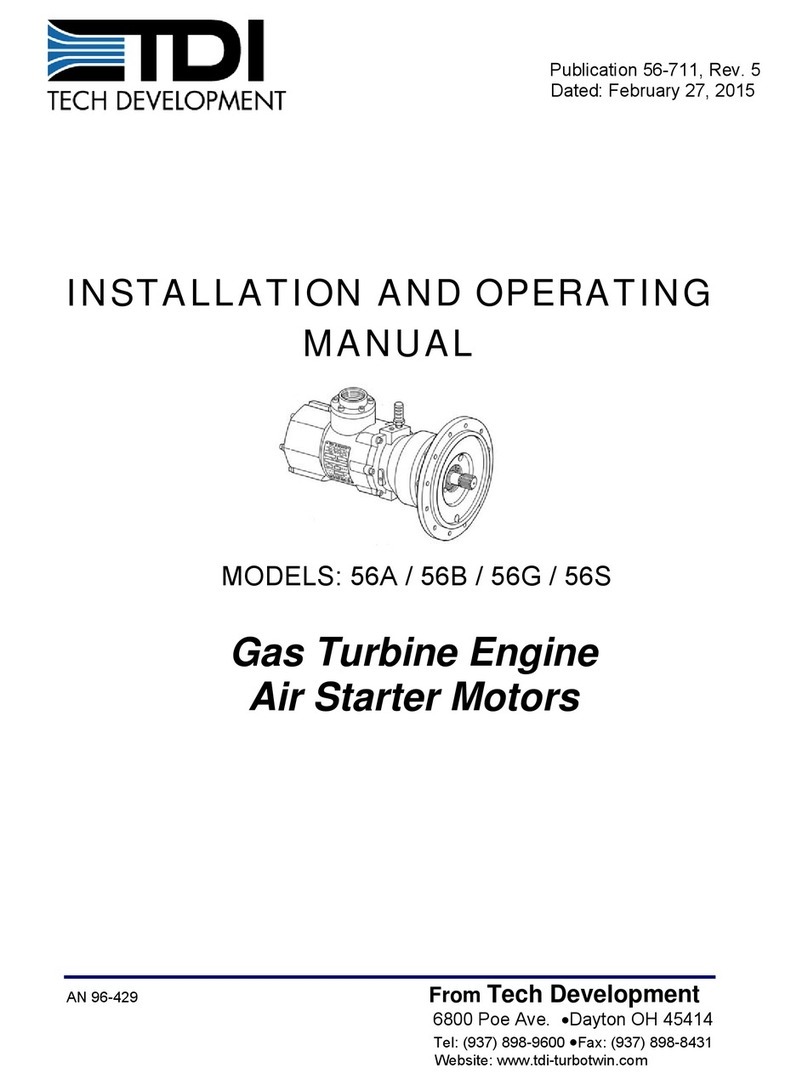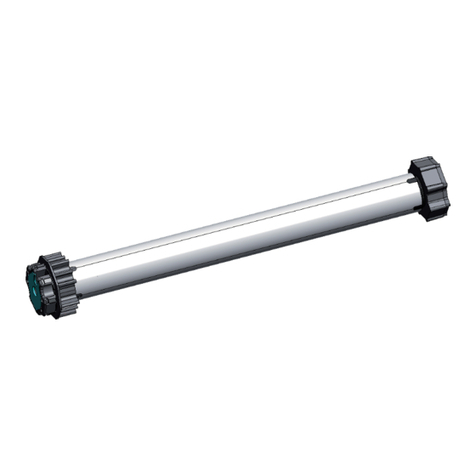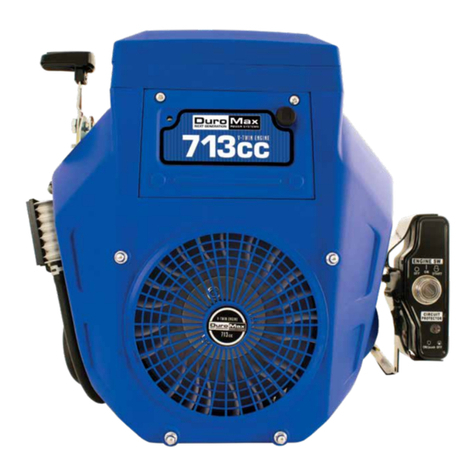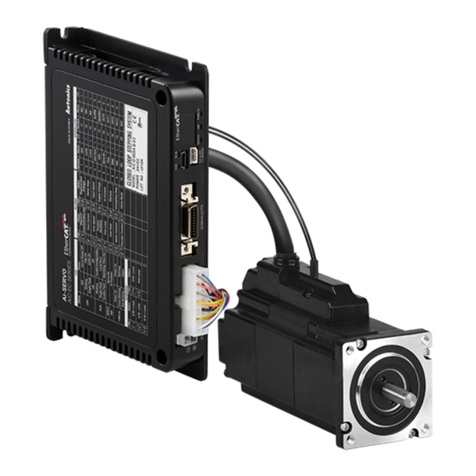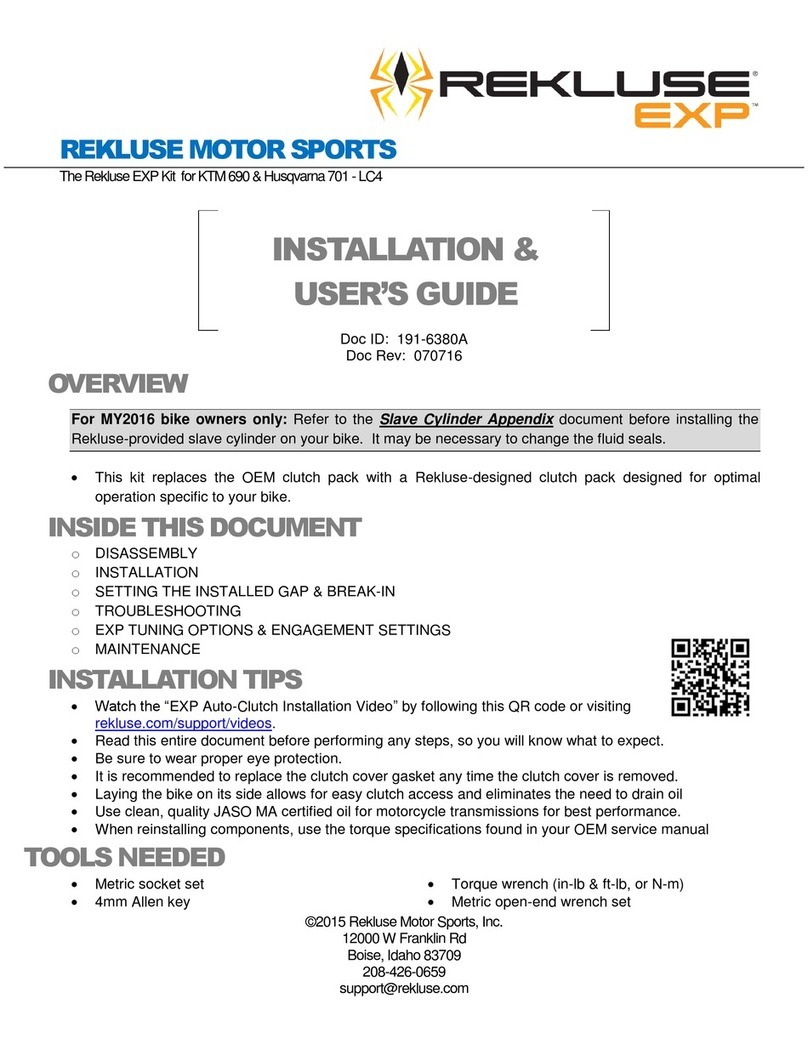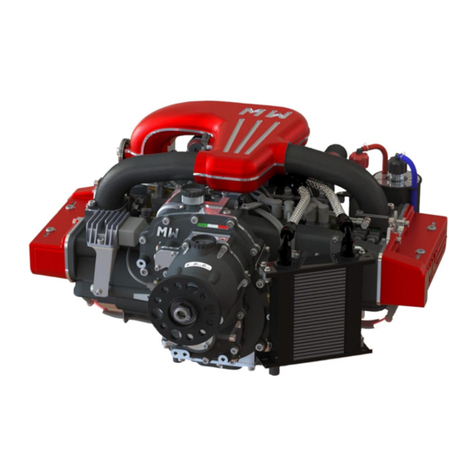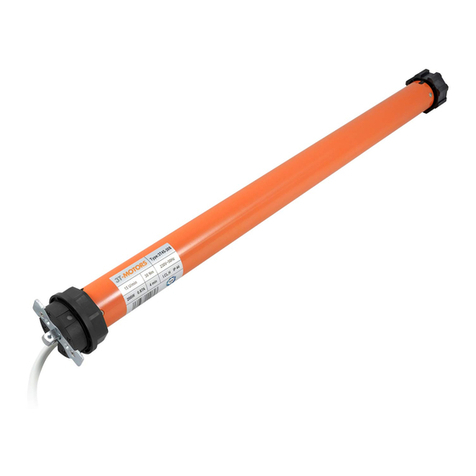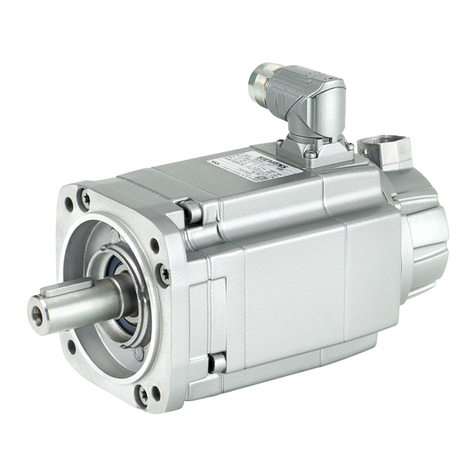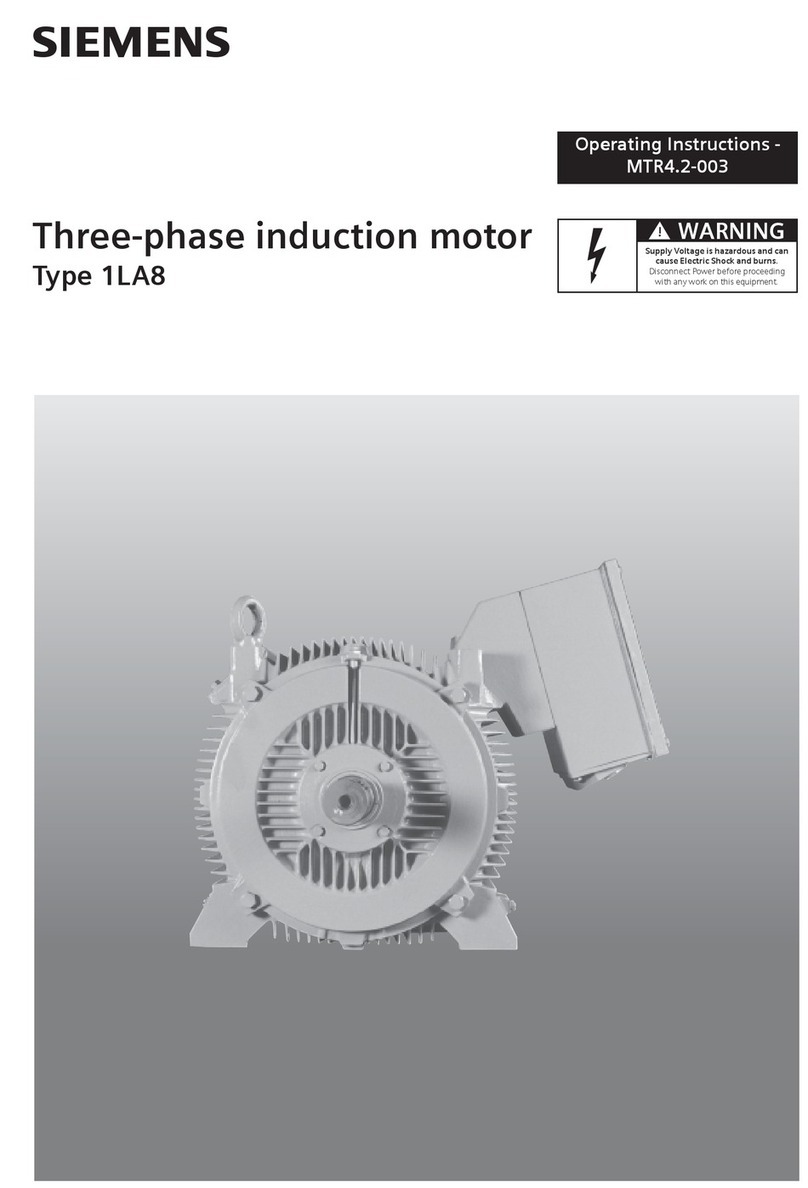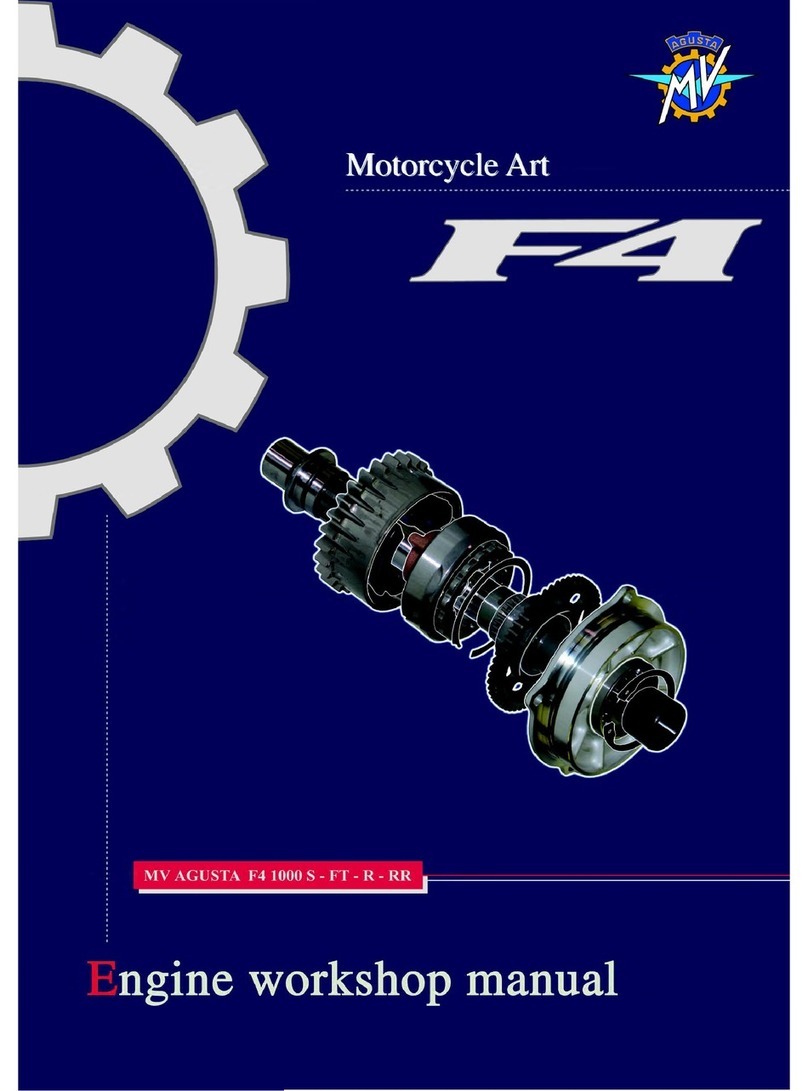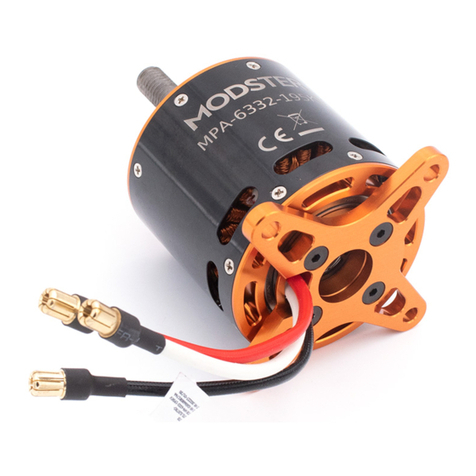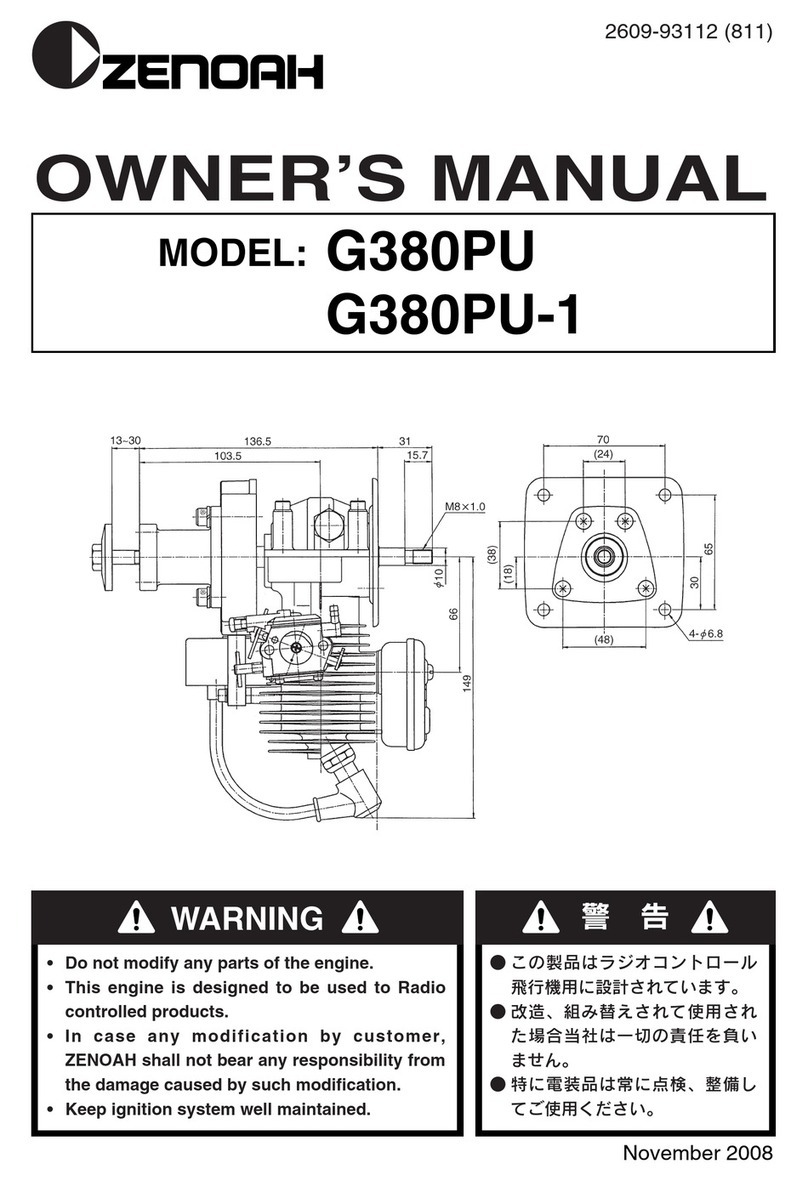TDI TURBOTWIN T100-MS User manual

AN08-482 From Tech Development
6800 Poe Ave. •Dayton OH 45414
Tel: (937) 898-9600 •Fax: (937) 898-8431
Website: www.tdi-turbotwin.com
Publication: T1-797
Issued: August 20, 2008
INSTALLATION AND OPERATING
MANUAL
TURBOTWIN™Model: T100-MS
Auxiliary Air Motors

TDI TURBOTWIN™
FROM TECH DEVELOPMENT
Publication: T1-797
Issued: August 20, 2008 Page 1
TABLE OFCONTENTS
SECTION SUBJECT PAGE
1.0 GENERAL INFORMATION……………………….2
1.1 DESCRIPTION & NEW FEATURES……………..2
1.2 BASIC OPERATION………………………………. 2
1.3 PRODUCT IDENTIFICATION……………………. 3
1.4 MOTOR PERFORMANCE & OUTPUT…………. 3
2.0 INSTALLING THE MOTOR……………………….5
2.1 ORIENTATION & LUBRICATION………………...6
2.2 SUPPLY & EXHAUST LINE INSTALLATION……7
2.3 MOTOR CONTROLS………………………………8
2.4 INLET PRESSURE CHECK PORT……………… 8
2.5 MATCHING MOTOR OUTPUT TO LOAD……….8
3.0 MOTOR OPERATION……………………………..8
4.0 PREVENTIVE MAINTENANCE…………………..9
5.0 TROUBLE SHOOTING GUIDE………………….. 10
6.0 TURBOTWIN WARRANTY………………………...11

TDI TURBOTWIN™
FROM TECH DEVELOPMENT
Publication: T1-797
Issued: August 20, 2008
Page 2
1.0 GENERAL INFORMATION
Instructionsfor installation, operationandmaintenance
of TDI TURBOTWIN™Model T100-MS Auxiliary Air
Motors. These are suitable for use on a variety of
[Solar] applications including on Saturn, Centaur &
Taurus machines. T100-MS AuxiliaryMotorsareused
primarily forWetSeal System OilPumpdrivers,or Pre-
Post Lube Oil Pump drivers (as upgrades).
Review this manual before installing or operating
T100MS Model Air Motors. Questions? Contactyour
Authorized TDI Distributor, OEM or TDI directly.
WARNINGS, CAUTIONS AND NOTES
Certain types of information are highlighted in this
manual for your attention:
WARNINGS: - used where NON-
COMPLIANCE will likely result in injury to
personnel or damage to the equipment.
CAUTIONS: - used where there is possibility
of damage to the equipment.
NOTES/IMPORTANT: - used to point out
special interest information or “optimum” use
scenarios.
1.1 DESCRIPTION & NEW FEATURES
T100-MS Aux. Air Motors are extensively upgraded
versions of previous T100M models. The “S”
character (within in the new model nomenclature)
designatesthe incorporation ofmanymodificationsand
new product features including:
oWet-sump (Splash) Oil Lubrication of
planetary gear set & drive end bearings.
oSealed (Vent-less) Gearbox w/Sight Glass
for easy oil level maintenance.
oHigher (ABEC) Spec Turbine Bearings.
oHigher Spec Double-lip Shaft Seals.
oNitride Treated planetary ring gear.
oHigher precision Dynamically Balanced
Rotors.
oNew Labyrinth-Type Primary Seal.
oProprietary Gearbox Venting System
oBalanced Pressure Venting of aft
seal/bearing
NOTE
THIS MOTOR IS TO BE SERVICED ONLY BY AUTHORIZED TDI
TURBOTWIN™ DISTRIBUTORS, DEALERS, AND REPAIR
STATIONS. DO NOT OPERATE THIS MOTOR UNLESS IT IS
PROPERLY ATTACHED TO AN ENGINE.
NOTE
External dimensions of delete new T100-MS Motor
Motors are near identical to previous T100-M Motor.
However, previous TDI Motor models cannot be
economically upgraded to incorporate the many
additional features found in the newer models
oTURBOTWIN Upgrades can be easily installed,
generally without inlet/exhaustpiping changes.
oAll TURBOTWIN Motors are designed for
operation on either compressed air or on
natural gas.
oTURBOTWIN materials are compatible with
“sour” natural gas and marine environments.
oTURBOTWIN T100MS Motors are ATEX
certified.
oAs with all TURBOTWIN turbine Motors, mist or
injection type lubrication of the air/gas supply is
NOT required. (remove external lubricators).
NOTE
Throughout this manual, the term “air” is used to
designate the Motor drive medium. Unless other wise
stated, "air" means either compressed air or natural
gas.
1.2 BASIC OPERATION
TURBOTWIN T100-MS air Motors are simple two-stage
turbine driven, gear reduced air Motors, with the
following key differences vs. other types of Motors
commonly used in similar (pump) applications:
Unlike electric Motors, power output and
operating speeds correspond (and vary
widely) depending on the dynamic operating
pressures supplied to the Motor inlet and the
load imposed. (see performance data).
Unlikevane-type or rotaryscrew-type(positive
displacement)Motors, turbinetypeair Motors,
if unloaded/under loaded will operate at much
higher free-speeds.
Turbinetype Motors mustbeproperly selected
and regulated to operate efficiently, at a
required loaded speed, rather than over a
widerange of inletsupplypressures& speeds.

TDI TURBOTWIN™
FROM TECH DEVELOPMENT
Publication: T1-797
Issued: August 20, 2008 Page 3
The basic operation of the Motor is as follows:
Pressurized air or natural gasenters theMotor through
the inlet port. The compressed air expands through
thetwo-stage turbine,whichthrougha gearbox (speed
reduction), results in shaft rotation (Motor output).
Upon completion of its cycle, turn off the air to the
Motor immediately. Minimizing the time the Motor is
operating, especially unloaded, maximizes Motor life
IMPORTANT
To attain maximum product life, it is important to
properly match the Motor inlet supply pressure,
power output and Motor speed to required load.
Regulate (if necessary) Motor supply air
pressure to the lowest possible setting
required to drive the load (pump). No more.
There are two pressure check ports on the
Motors (at inlet & exhaust), that allow users to
check the dynamic inlet supply pressure &
exhaust (back) pressure applied to the Motor.
Minimizing Motor exhaust back pressure will
extend the life of air Motor. Back pressure
should not exceed 15 psig. or may otherwise
shorten the life of the Motors’ rear seals &
bearings.
Dynamic pressures are measured with the
Motor running, by taking readings at the
aforementioned pressure check ports on the
Motor housings.
1.3PRODUCT IDENTIFICATION
The identification nameplate(s) attached to Motor
housing should indicate the following information:
Model designation
P/Ns(OEM &/or aftermarket p/ns may be
present on the Motor data tag(s).
Serial Number (date of manufacture)
Maximum Operating (Inlet) Supply Pressure
Direction of Rotation
PART NUMBER IDENTIFICATION TABLE
TDI Part Number Solar Part Number
T103-60010-MSL-0-E0 1083842
T106-60010-MSL-1-40 1078365-400
T112-60010-MSL-1-40 1078365-500
T112-60010-MSR-1-40 1078365-600
NOTE
Direction of Rotation is either left hand (LH) rotation
(CCW) or right hand (RH) rotation(CW)always viewed
looking into the output (shaft) end of the air Motor.
CAUTION
Exceeding the Maximum Operating Pressure rating
shown on Motor nameplate may result in damage to
the Motor or damage to the driven equipment.
NOTE
Maximum Operating Pressure is indicated on the
nameplate. This can (should) be measured at the
pressure check port below Motor inlet port, and set
dynamically (while the Motor is in operation) as
described in Sec. 1.2.
IMPORTANT
Optimum (correct) Operating Pressure is not
necessarily the dynamic Motor supply pressure
recommended for your application. Motor supply
pressure optimization, per application, has been
provento maximizethe service lifeand reliabilityofthe
Motor(s) in most all applications. (See section 1.2)
NOTE
Proof Pressure, if shown on the nameplate, indicates
the maximum static pressure rating at which Motor
turbine Motor housing(s) will not burst in operation.
1.4MOTOR OUTPUT AND
PERFORMANCE
Please refer to specific Performance Graphs of the
model being applied which illustrate:
Motor Output (shaft HP/Torque) over range of
dynamic supply pressures & speeds [0 RPM
(stall) to maximum free speed] is indicated on
the performance graphs of each model.
AirConsumption Ratesoverrange of dynamic
supply pressures (consumption is constant at
dynamicinlet pressuresisalso indicated inthe
tables on the performance graphs for each
model. Consumption varies by pressure only,
…not by output speed.
Motor consumption, output & operating speed
may vary considerably on DIFFERENT drive
mediums (e.g. air vs. methane gas). Supply
pressure should adjusted accordingly.

TDI TURBOTWIN™
FROM TECH DEVELOPMENT
Publication: T1-797
Issued: August 20, 2008
Page 4
Model: T103-MS Performance Curve
3 Nozzles, Natural Gas 7.5:1
0
10
20
30
40
50
60
0 5 10 15 20 25 30 35 40 45 50 55 60 65
Pinion Speed (RPM *100)
TORQUE
LB-FT
0
3
6
9
12
15
18
POWER
HP
90 Psig
60 Psig
INLET
PRESSURE FLOW
PSI SCFM
90 283
60 200
30 120
30 Psig
Curve #023DE
13 Feb 2008
Onmethane gas,Motor produces significantly
more HP at higher speeds. Inlet supply
pressuresmayneed to be reduced(regulated)
accordingly, to prevent excessive Motor/pump
speed (over speed).
In all cases, indicated performance assumes
exhaust routed to atmospheric pressure, and
combustible gasses used are piped to a safe
location. Motor exhaust system piping
should minimize back pressure, not to
exceed 15 psig.
Model: T106-MS Performance Curve
6 Nozzles, Natural Gas 9:1
0
25
50
75
100
125
150
175
200
0 5 10 15 20 25 30 35 40 45 50 55 60
Output Speed (RPM *100)
TORQUE
LB-FT
0
7
14
21
28
35
42
49
56
POWER
HP
150 Psig
120 Psig
90 Psig
60 Psig
INLET
PRESSURE FLOW
PSI SCFM
150 895
120 716
90 565
60 401

TDI TURBOTWIN™
FROM TECH DEVELOPMENT
Publication: T1-797
Issued: August 20, 2008 Page 5
MODEL: T112-MS PERFORMANCE CURVE
P/N: T112-60010-MSL-1-40
P/N: T112-60010-MSR-1-40
12 Nozzles, Natural Gas 9.0:1
0
50
100
150
200
250
300
350
400
0 500 1000 1500 2000 2500 3000 3500 4000 4500 5000 5500 6000
Output Speed (RPM)
Torque (lb ft)
0
15
30
45
60
75
90
105
120
Power (Bhp)
Inlet
Pressure Flow
(Psig) (SCFM)
150 1790
120 1432
90 1130
60 801
150 psig
120 psig
90 psig
60
p
si
g
2.0 INSTALLING THE MOTOR
TDIT100-MS Motorsfeature a turbinetypeair
Motor that does not require lubrication in the
supply air. This is a separate consideration
from the lubrication of the Motor gearbox,
adiscrete internal oil sump which requires
oil maintenance (oil fills, checks &
changes).
If a vane-type Motor is being replaced by a
TDI turbine type Motor, TDI recommends
removal of in-line/mist type lubricators to
minimize their inherent flow restriction to the
Motor and eliminate this maintenance item.
CAUTION
All T100-MS/CS Motors should be installed with the
inlet either straight down (6 o’clockor180 degrees)or
straight up (0 degrees or 12 o’clock). In all cases,
orientation of gearbox sight glass must be just
below the Motor/Motor centerline, to insure proper
indication/maintenance of gearbox oil level (see
section 2.1).

TDI TURBOTWIN™
FROM TECH DEVELOPMENT
Publication: T1-797
Issued: August 20, 2008
Page 6
2.1 PROPER INSTALLATION, ORIENTATION & OIL LEVEL MAINTNENACE
Motor/Motor Gearbox must be filled w/ (150ML) of Approved Oil Type** & Level Maintained
** Oil Type Recommended: Spec MIL-L-7808H, MIL-L-23699 (or equivalent synthetic grade turbine oil)
OIL FILL PORT ½”-
14 NPT
OIL LEVEL
SIGHT GLASS
ORIENTATION
Viton O-ring
seal beneath 2”
NPT inlet flange
Viton O-ring seal
beneath 3”
exhaust adapter
flange
NOTE: PROPER INSTALLATION -
OIL LEVEL SIGHT GLASS
POSITIONED PARALEL TO
GROUNDLINE & BELOW
MOTOR
/
MOTOR CENTERLINE
Motor
Output Shaft
& Mating
Spline
Engine Aux.
Gearbox
Splash-lube
Gearbox

TDI TURBOTWIN™
FROM TECH DEVELOPMENT
Publication: T1-797
Issued: August 20, 2008 Page 7
NOTE
TDI recommends synthetic grade oil (turbine oil) is
used in the Motor gearbox sump. Use of either
improper synthetic or mineral based oils may
compromise unit service life, void manufacturer’s
warranty, and will increase the frequency of
maintenance intervals required.
WARNING
Do not operate this Motor unless gearbox has been
filled to the proper oil level and maintained at this
level.
WARNING
Do not operate this Motor unless it is properly
connected to a load (see below).
2.2 SUPPLY LINE & EXHAUST LINE
INSTALLATION
WARNING
Be sure to either bleed the pressurized air reservoir
and/or safety the system such as closing all air/gas
supply valves, prior to installing Motor or a new
supply line.
T100 TURBOTWIN T100-MS Motors come standard
with a 2" NPT female pipe thread adapter for the inlet
connection port & various 3” exhaust adapters.
Various flanged or threaded adapters may be utilized
at these joints. Supplied adapters are sealed to the
Motor housing with Viton O-rings (see section 2.1).
Hard piping may be used on supply/exhaust lines. A
sections of (gas approved) flexible tubing is
recommended, between Motor inlets/outlets, to the
hard piping… to prevent leaks or “wobble” out due to
piping weight & vibration, and for ease of field
maintenance/replacement of the Motor(s).
The supply line consists of the line from the air/gas
supply source (via a pressure regulator when
necessary) through filters, manual and/or automatic
relay valves, to the Motor inlet.
The exhaust line consists of the line from the Motor
exhaust to a “safe” location. Turbine exhaust (air) is
typically plumbed away from the engine area.
Motor supply & exhaust lines and components should
bedry-fitted forproper alignment/location,priortofinal
assembly.
All pipe threaded joints should be sealed with Loctite
Pipe Thread Sealant (TDI P/N 9-94085) or equivalent,
for leak tight joints prior to final assembly. Be sure to
tighten all joints to proper torque after final assembly.
The installation of the Motorusing naturalgas issimilar
to the air installation except all fittings, piping, valves
and regulators must be compatible with natural gas
and gas industry regulations.
WARNING
When using natural (or combustible) supply gas
(e.g.methane gas)must be pipedto asafe location,
routed and terminated according to industry codes
and local regulations.
NOTE
If the supply line is longer than 40 feet, the supply line
pipingsize mayneed to beincreasedto2"diameter,to
minimize dynamic flow losses through piping and
ensure specified output. Similarly, if exhaust piping is
longer than 40 ft. in length, it may be necessary to
increase its diameter from 3” to 4” to minimize Motor
exhaust back pressure and insure specified output.
On higher HP (T112-MS) applications, valves or
regulators on the supply side, having a Cv of 40 or
higher, are recommended. This is a lesser concern for
Motors having 6 or 3 nozzles (T106-MS & T103-MS).
In all cases, care must be taken to insure all inlet
supply line piping & components are capable of
passing the required air flow needed to produce
specified power levels (Motor output).
See Motor performance chart for specific
flow rates.
WARNING
Be sure that any/all piping &/or tubing used, meets
applicable requirements and that no leaks are
present following line installation or thereafter.
CAUTION
Although the light weight of these Motors is easily
supported by their mounting flange designs, TDI
recommendsproperly bracing allrigidpipingattached
to the Motors… to eliminate axial strain on Motor &
Motormounting flanges. High axialloads(“over-hung
bending”) will greatly reduce Motor life.
CAUTION
There is often weld slag, grindings, thread shavings,
hardened compounds and other heavy debris in new

TDI TURBOTWIN™
FROM TECH DEVELOPMENT
Publication: T1-797
Issued: August 20, 2008
Page 8
packagepiping &at new siteinstallations. Therefore,
at commissioning (before running Motors), TDI
recommendsa “blow-down”proceduretopurgeMotor
supply lines of all hard debris that may otherwise
damage the Motor severely. While T100
TURBOTWIN Motors are highly tolerant of
contamination in the air/gas supply, Motor life can be
greatlyincreased by usingacoarsemesh strainer. At
sites where dirty supply air/gas is present, use &
maintenance of a #40 mesh Y-strainer, upstream of
the Motors, is highly recommended.
NOTE
Expensive moisture abatement (air/gas drying) is not
required, as this has no effect on the Motors.
2.3 MOTOR CONTROLS
A preferred Motor supply control valve is typically a
pilot-operated type, which can be pneumatically or
electrically actuated. The valve should be located
relatively close to the Motor inlet, to prevent Motor
over-running at the end of the cycle.
CAUTION
Proper supply pressure “matching” and over-speed
control is highly recommended on all installations of
Models T100MS (See section 2.5)
Do not use max supply pressure indications only, as a
method to properly set the Motors’ supply pressure. A
pressure regulator is required, where dynamic air/gas
Motor supply pressure is great enough to exceed the
Motor operating pressure (at the inlet port) and/or
where a “default” supply pressure (e.g. engine fuel
gas pressure) would produce Motor output speeds
beyond what is specified for the application.
(Result is over-speed, not necessarily an indicated
over-pressure). Both over-pressure & over-speed
will reduce life of Motors/pumps & wastes supply
air/gas (increases operating costs).
2.4 INLET PRESSURE CHECK PORT
(checking dynamic operating pressures)
A 1/4" NPT port is located on theMotor housing,under
the air inlet. This port can be used to check the supply
pressure at the Motor when the Motor is operating. To
check dynamic pressure, remove the 1/4" NPT pipe
plug and save for later use. Install a pressure gauge to
read at this port. Using Loctite Pipe Thread Sealant or
equivalent, replace¼” NPT pipeplugwhendone. This
pressure monitoring line/gauge may also be
permanently installed. Alternately, a pressure
transducer may be installed at the pressure check port
and electrical lines routed to a digital display or panel
at the operator's station.
2.5 MATCHING MOTOR OUTPUT (SPEED)
TO LOAD
It is recommended that all T100-MS Motors be
installed with a discrete Motor supply pressure
regulator. A hand held tachometer should be used to
double-check Motor output speeds. Motor supply
pressure should be set at the minimum pressure
required to insure the Motor runs the speed/load
required by the application. Oil Pump discharge
pressure may not indicate excessive motor speed,
since an oil bypass (relief valve) may reduce this to a
indicate a “normal” oil pressure reading.
Donot applythe maximum Motorsupply pressureonly
by default, (such as default fuel gas pressure on the
package). As indicators of Motor speed & output, this
typically does not account for:
Varyingfuel gaspressures (on variousturbine
engine models)
Varying oil pumps, oil types & loads.
Varying site conditions (temperatures, etc…)
Varyingoil pressures (wet-sealoilpressurevs.
lube oil pressures) & cycle times required.
NOTE
Motor over-pressure (even where Motor supply
pressure minimally exceeds that needed for pump
loads, may result in pumps turning faster than
necessary of a.k.a. “over speed.” In this case simply
reducing Motor supply pressure will correct this.
This also reduces consumption and lowers supply
air/gas costs.
3.0 MOTOR OPERATION
WARNING
Do not operate the TDI TURBOTWIN Motor at
dynamic supply pressures greaterthan the pressure
rating on the nameplate. This dynamic pressure is
measured at the Motor inlet while the Motor is
running.

TDI TURBOTWIN™
FROM TECH DEVELOPMENT
Publication: T1-797
Issued: August 20, 2008 Page 9
Static (non-flowing) supply pressure will
always behigher thantheoperating (dynamic)
pressure.
The maximum pressure limit (proof pressure)
that the TDI TURBOTWIN Motor housings may
be subjected to is 600 PSIG (42 BAR).
Where system static pressuremay exceedthe
600 PSIG (42 BAR) limit, in addition to
pressure reducing device, a pressure relief
valve (set below 600 PSIG [42 BAR], should
be used.
Where operating supply pressure exceeds
Motors’ maximum operating pressure ratings,
or produces outputs above required by the
application, a pressure reducing device
(regulator) must be used.
All appropriate local pressure codes and pressure
limitations on other system components must be
adhered to and supersede the guidelines given in this
manual.
4.0 PREVENTIVE MAINTENANCE
IMPORTANT
All TURBOTWIN T100-MS/CS Motors use new oil-
sump lubrication of the drive end (gearbox) which
must be properly maintained.
Severe Service ** & Required Field
Maintenance Procedures,to be performed
as preventative maintenance include:
oUtilize only oil types recommended
by the manufacturer (TDI), in the
Motor gearbox.
oProperly orient the Motors as
described herein, to insure proper oil
levels can be easily checked &
maintained in the Motor gearbox
(See section 2.1)
MAINTENANCE SCHEDULE
INTERVAL CHECKS MAINTENANCE
2,000
operating
hours (or
quarterly)
Check Oil
Level,
Fill as
necessary.
Check oil
condition;
change oil as
necessary, OR
if using oil other
than
recommended
synthetic types
4,000
operating
hours (or
semi-annually)
Check Oil
Level
Fill as
necessary.
Check oil
condition;
change oil as
necessary, OR
if using oil other
than
recommended
synthetic types
8,000
operating
hours (or
annually)
Check Oil
Level Change Oil
(regardless of
type being used)
** Severe Service:is where Motor(s) are cycled
longer than one (1) hour continuously or wherever
Motor(s) can/may become unloaded for periods
longer than 30 seconds during cycle.
Repair techniciansor un-authorized/un-trainedservice
organizations, without TDI TurboTech certification,
should not attemptto rebuild norrepairtheseproducts.
Proper maintenance, qualified maintenance repair of
your TDI TURBOTWIN Motors & Motors will assure
continued reliable and superior performance for many
years.

TDI TURBOTWIN™
FROM TECH DEVELOPMENT
Publication: T1-797
Issued: August 20, 2008
Page 10
5.0 TROUBLESHOOTING CHART
TROUBLE PROBABLE CAUSE
SOLUTION
A. Y-Strainer or filter in supply line
clogged.
A. Clean strainer.
1. Motor does not run;
small air flow from
exhaust.
B. Nozzle blockage.
B. Remove blockage or obstruction from nozzles.
D. Broken/damaged turbine
rotor(s).
D. Replace all damaged parts.
B. Broken gear train.
B. Repair or replace gear train.
2. Motor does not run;
(rotate) but normal air
flow from exhaust.
C. Seized Load (e.g. oil pump)
C. Repair or replace pump (or driven device)
A. Motor inlet air pressure/flow
insufficient to produce required
Motor output.
A. Check dynamic operating pressure at Motor inlet.
Increase air pressure in 10 PSIG (0.6 BAR)
increments; DO NOT EXCEED OPERATING LIMIT.
B. Damaged turbine nozzle.
B. Replace turbine nozzle.
C. Inlet supply piping or
components too small.
C. Check dynamic operating pressure at Motor inlet.
Supply piping size (lengths/diameters) must match
dynamic flow requirements.
D. Pressure regulator orifice too
small.
D. Check dynamic operating pressure at Motor inlet.
Increase orifice size or replace pressure regulator to
one that matches pressure/flow requirements.
E. Inlet supply line valve (ball,
gate, relay, plug) too small.
E. Check dynamic operating pressure at Motor inlet.
Install valve that matches flow/pressure
requirements for application.
F. In line lubricator installed in
supply line restricting flow.
F. Check dynamic operating pressure at Motor inlet.
Remove lubricator.
G. Control Valve or Regulator not
fully open.
G. Check dynamic operating pressure at Motor inlet.
Repair or replace control valve or regulator as
needed.
H. Excessive back pressure;
exhaust restricted.
H. Check dynamic operating pressure at Motor
exhaust port. Clean exhaust piping or increase size
to length/diameter required for application.
J. Wrong rotation Motor.
J. Check rotation (direction) Replace with Motor of
proper rotation if necessary.
3. Reduced Motor
output power (will not
carry load).
K. Wrong size Motor.
K. Check the Application Guide for the correct Motor.
A. Motor Inlet air pressure too
high.
A. Check dynamic operating pressure at Motor inlet
Decrease air pressure in 10 PSIG (0.6 BAR)
increments.
OR
If there is a manual shut-off valve in the supply line,
partially close it to restrict dynamic Motor supply
pressure.
OR
Install a restriction orifice in the inlet supply line.
4. Motor & Pump turns
too fast. Excessive oil
pump output/pressure.
OR
Validate with a hand
tachometer if necessary.
B. Wrong size Motor.
B. Check Application Specifications for the correct
Motor.

TDI TURBOTWIN™
FROM TECH DEVELOPMENT
Publication: T1-797
Issued: August 20, 2008 Page 11
6.0 WARRANTY
TDI TURBOTWIN ENGINE MOTOR WARRANTY
Tech Development (TDI) warrants to the original user of the TDI TURBOTWIN™ air starters to be free from defects in material
and workmanship for a period of one year (6 month for remanufactured units) from the date of installation. The warranty period
shall not extend beyond two years (12 months forfactoryremanufactured units) fromthedatethe unit wasmanufactured.(i.e.:a
unit with a manufactured date of July 1999 (SN: 9907-101) will not be covered under warranty after July2001). The conditions
of this warranty are: a) TDI is notified within this period by return of such product to TDI or its authorized distributor/dealer,
transportation prepaid by user; b) the starter has been installed according to TDI’s specifications; c) the starter has not been
misused, abused, or improperly maintained by user; d) the defect is not the result of normal wear and tear; e) the starter has
been repaired with parts manufactured or authorized by TDI; and f) TDI installation and repair procedures as outlined in the
appropriate manual were properly followed.
Tech Development will repair, or at its option, replace the unit during the warranty period at no charge to the customer,
provided it is returned to TDI with the proper return procedure.
Tech Development makes no other warranty, and implied warranties including any warranty or merchantability or fitness for a
particular purpose are hereby disclaimed.
This warranty constitutes the entire obligation of Tech Development relating to the sale and use of such product and TDI’s
maximum liability is limited to the purchase price of such product at the date of purchase. In no event shall TDI be liable for
incidental, indirect, consequential, or special damages of any nature arising from the sale or use of such engine starter
product.
Other manuals for TURBOTWIN T100-MS
1
Table of contents
Other TDI Engine manuals
